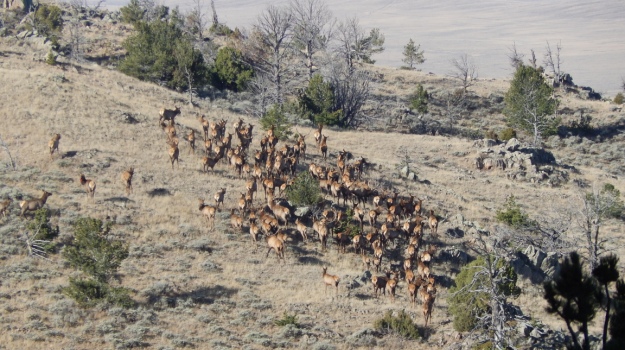
I had been hunting elk for three years unsuccessfully. I was really getting frustrated about not being able to close the deal. So, I went on a rifle hunt in an area that had a lot of hunting pressure. We got on top of a high peak and watched a herd of elk about 1-1/2 miles away from where we were. While we were watching the elk, we noticed other hunters moving in on the herd. Those hunters spooked the elk, and the elk started running toward us. The elk came up on a hillside just across a canyon from where my wife Rena and I had set up to watch the herd. At that time, the only rifle rest I had was a boulder. I picked out a cow that was 230 yards from me. As soon as I squeezed the trigger, the cow went down. I was shooting a .338 Win Mag. When that cow went down, I had an unbelievable feeling of relief.
I know that most elk hunters believe that the antlers of a big bull are the real trophy that an elk hunter seeks. However, after working as hard as I had worked for three years of hunting elk and never having the opportunity to tag one, that cow laying on the side of the mountain was one of the greatest trophies I had ever taken. I put in 60 days or more each season by hunting with a bow and a rifle and hadn’t taken an elk. So, taking that cow was the fulfillment of a lifelong dream.
Rena, my 14-year-old son Cody, and a friend of ours were on this hunt. The four of us had frame packs, and we only carried out about 50 pounds of meat each. We made two trips to get the cow out. Luckily, we had been able to get the truck to within 1/2-mile of where I took the elk. We were all looking forward to eating the meat. I had eaten farm-raised elk back in North Carolina, but I have to be honest; it wasn’t nearly as tasty as the first elk I took in the mountains. My favorite recipe for elk is chicken-fried elk steaks.
We hunt two different mountain ranges each season – the Snowy Range, located on the northern fork of the Rocky Mountains, and the Laramie Range. Both these mountain ranges are in the Medicine Bow National Forest that covers 1,714 square miles. Most western hunters depend on the elk as their primary meat source, and the cows seem to be more tasty and tender than the bulls.
As a resident, we can get a $48 cow tag but that same tag will cost a nonresident about $300. An elk tag that will allow a resident hunter to take a bull or a cow costs about $60, and that same tag for a nonresident costs $700. Depending on the area, we can get up to three cow tags per hunter per year. To supply meat for our family, Rena and I try to harvest either one bull for the freezer or two cows per year.
Although I took that first cow with my rifle, Rena and I both are avid bowhunters. So, each year we primarily hunt with our bows. If we don’t take the elk we need for the freezer, we’ll hunt with rifles. I've been fortunate enough to take two bulls with my bow, and Rena has taken one bull with her bow.
Day 1: Get in Shape for Elk Hunting
Tomorrow: Chad Parsons’ First Bull Elk with a Bow



























